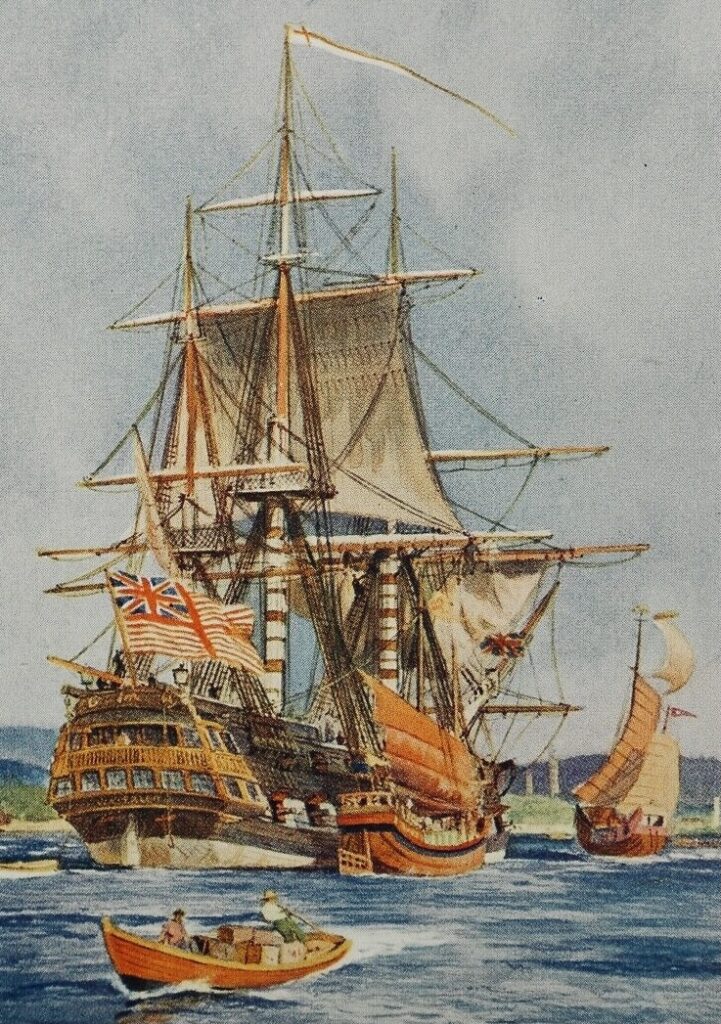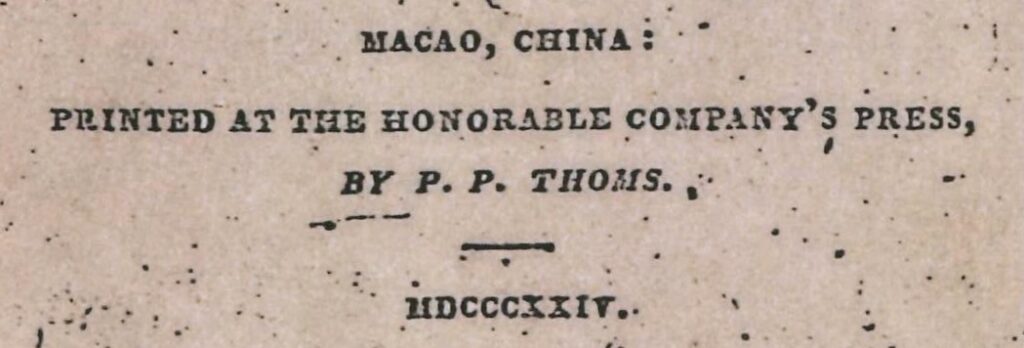The English East India Company (EIC), also known as the “Governor and Company of Merchants in London, trading into the East Indies,” was founded on 31 December 1600. The company was granted a royal charter from Queen Elizabeth which enabled it to have monopoly on trade with the East Indies. Historically, the term East Indies referred to the eastern part of world, from the Indian subcontinent and Southeast Asia to East Asia. The power of EIC came not only from its immense wealth but also from its armed forces which allowed it to rule a large part of India. EIC was called the Honorable Company, or simply the Company due to its unrivaled position in the 17th and 18th century. In 1858, the British Government took over trade monopoly, administration of India, and the armies from EIC, and eventually the company was dissolved in 1874.1
Today, the Chinese translation of East India Company is 東印度公司. The term 公司 (gung1 si1) stands for ‘company.’ Individually, 公 means ‘common, public’ and 司 means ‘officer, department, to control or manage.’ In the 19th century, another term 公班衙 was also used. Sir John Francis Davis was the son of Samuel Davis (1760–1819), director of East India Company. He was appointed writer of the English Factory in Canton, Superintendent of British Trade in China in 1833, and Second Governor of Hong Kong in 1844. He compiled a vocabulary thatcontained common terms relating to trade in Canton and Macao. The entries for EIC or 公司 are shown below.2
COMMITTEE, 列位掌管事 Lëě-wei-chang-kwan-sze. That of the British Factory generally known at Canton by 公司 Kung-sze.
COMPANY, EAST INDIA, 公班衙 Kung-pan-ya. 英吉利國貴公班衙 Ying-keĭh-le-kwŏ Kwei Kung-pah-ya.
英吉利國referred to ‘England.’ The form 公班衙 seemed to be a transliteration of Portuguese companhia or Spanish compañía.
Though primarily engaged in trade, EIC was also involved in other activities, such as printing books. As transoceanic travel was an expansive and dangerous endeavor several centuries ago, it was not uncommon to find missionaries aboard merchant ships. In fact, both merchants and missionaries desired for expansion – the former group was immersed in profits, while the latter was interested in missionary outreach. Catholicism was brought to territories like Macau, Japan, Taiwan, and the Philippines, where the Portuguese and Spanish settled. Protestant countries like Britain and United States of America also sent missionaries to Asia.

Robert Morrison (馬禮遜, 1782–1834) of the London Missionary Society arrived in Macao and Canton in 1807. Because of his knowledge on the Chinese language, he was appointed translator for the EIC in 1809. This position allowed him to remain in Macao and Canton so that he could continue his religious activities. The availability of Chinese character font made at the expense by the EIC enabled Morrison to publish one of his major works – A Dictionary of the Chinese Language: In Three Parts (1815–1823). Also written by Morrison was Vocabulary of the Canton Dialect (1828), an important book for Europeans to learn Cantonese.
John Robert Morrison (馬儒翰, 1814–1843), son of Robert Morrison, was appointed as Chinese Secretary for the EIC.He published A Chinese Commercial Guide, Consisting of a Collection of Details Respecting Foreign Trade in China (1834). The book contained a short section titled “Glossary of words and phrases peculiar to the Jargon spoken at Canton.” The jargon in question here was Pidgin English. Some examples of pidgin expressions are as follows.3
Can do? Will it do? Also used through, mistake, for ‘how d’ye do?’
Catchee, To get, to bring, to find, &c.; also to become, as ‘this thing hab catchee cold,’ for ‘this has become cold.’
Chinchin, from Chinese tsing, to request, and tsing ah, a salutation. To ask, to thank, to salute, &c. Chinchin joss, to worship the gods.
Chop, from Malay chapa, a seal or stamp, any thing sealed or stamped; hence government edicts, licenses, &c., also stamped or printed documents. Again, a thing licensed, as a chop-boat; a place able to give licenses, as a chop-house, i.e. a custom-house.
Chop is also used as synonymous with ‘quality,’ as first chop or No. 1 chop, for ‘best quality.’
Chop-boat is a kind of cargo boat, also used, when fitted up, as a travelling boat for foreigners.
Chop-chop, quick, fast, as too muchy chop-chop, for ‘very quick.’
Explanations of such pidgin words and phrases were strong evidence that the language was essential for cross-cultural communication. J. R. Morrison died in 1843 and was buried, alongside his parents, in Macao’s Old Protestant Cemetery built by the East India Company. EIC’s monopolistic trade in China also ended in that year.
Samuel Wells Williams (衛三畏, 1812–1884) arrived at Canton in 1833 as a missionary-printer to take charge of the printing press of the American Board of Commissioners for Foreign Missions there. Williams was deeply interested in the Chinese language. Among his major books were Easy lesson in Chinese (1842) 《拾級大成》and A Tonic Dictionary of the Chinese Language in the Canton Dialect (1856) 《英華分韻撮要》. Together with Elijah Colman Bingham, Williams was editor of the monthly periodical Chinese Repository 《中國叢報》. In 1836, the Repository published an article titled “Jargon spoken at Canton: how it originated and has grown into use; mode in which the Chinese learn English; examples of the language in common use between foreigners and Chinese”. Though the article was anonymously written, some people believed it was the work of Williams. Like J. R. Morrison’s glossary, “jargon” referred to Pidgin English. A story told in Pidgin was given in order to illustrate the features of the language. The story was about a European discussing with a Chinese shopkeeper on how his books should be repaired.4
Shopkeeper: my sabbee velly well, can fixee that book alla proper
how fashion you wanchee bindee?
European: My wanchee take go way alla this cover, puttee nother piece
Shopkeeper: I savy; you wantchee lever, wantchee sileek cofuh?
European: Alla same just now have got; you can do number one proper?
Shopkeeper: Can do, ca- -an.
The question word how fashion, meaning ‘in what manner’, was used like how. Apart from grammatical differences, the sound systems of Cantonese and English also differ in some respects. The sound /v/, like /r/, is not present in Cantonese, so Chinese speakers might use /f/ instead, as in cofuh ‘cover.’ Another difference concerns the structures of syllables. English allows several consonants to occur side by side within a syllable. This is known as consonant clusters. For example, the beginning of street has three consonants: /s/, /t/, and /r/. Consonant clusters are not permitted in Cantonese. Therefore, when pronouncing the word silk, the shopkeeper inserted a vowel to separate the consonants /l/ and /k/, resulting in the spelling sileek. Alla same came from the expression ‘all the same’. Proper could mean ‘correct(ly), proper(ly), all right.’
1. Gardner, Brian. 1971. The East India Company: A History. New York: Barnes & Noble Books.
2. Davis, John Francis. 1824. A Vocabulary, Containing Chinese words and Phrases Peculiar to Canton and Macao, and to the Trade of those Places. Macao: The Honorable Company’s Press, by P.P. Thoms.
3. Morrison, John Robert. 1834. A Chinese Commercial Guide, Consisting of a Collection of Details Respecting Foreign Trade in China. Canton: The Albion Press.
4. Anonymous. 1836. Jargon spoken at Canton: how it originated and has grown into use; mode in which the Chinese learn English; examples of the language in common use between foreigners and Chinese. Chinese Repository, January, 428-435.
